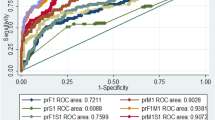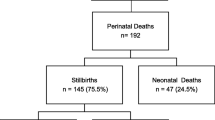Abstract
Objective
The objective was to review all obstetric admissions to the intensive care unit (ICU) at the Royal Free Hospital, London, UK, and to identify the risk factors for obstetric admissions to the ICU.
Method
We carried out a retrospective case-control study. The cases consisted of women admitted to the ICU during pregnancy and up to 42 days postpartum between 1 January 1993 and 31 December 2003. Controls were women who delivered immediately before and after the indexed case. Demographic data, medical and surgical histories, pregnancy, and intrapartum and postpartum data were collected. Statistical analysis was done using SPSS software.
Results
Thirty-three obstetric patients were admitted to the ICU, representing 0.11% of all deliveries. The ICU utilization rate was 0.81%. Eighty percent of the admissions were postpartum. The main indications for admission were hypertensive disorders (39.4%), and obstetric haemorrhage (36.4%). There was no difference between cases and controls in, age, parity, smoking and employment status. Compared with controls, women admitted to the ICU were significantly more likely to be black (P<0.05), have a shorter mean duration of pregnancy (36.6 vs. 39.2 weeks; P=0.006), delivered by emergency caesarean section (P<0.001), and have higher mean blood loss at delivery (1,173 vs. 296 ml; P<0.001). The risk factors for obstetric ICU admission were black race (odds ratio [OR] =2.8, 95% confidence interval [CI] 1.05–6.28), emergency caesarean section (OR=14.9, 95% CI 5.38–41.45) and primary postpartum haemorrhage (OR=5.4, 95% CI 1.79–4.35).
Conclusion
Women of black race, those delivered by emergency caesarean section and those with primary postpartum haemorrhage are more likely to be admitted to the ICU.
Similar content being viewed by others
References
Ben Letaifa D, Daouas N, Ben Jazia K, Slama A, Jegham H (2002) Maternal emergencies requiring controlled ventilation: epidemiology and prognosis. J Gynecol Obstet Biol Reprod (Paris) 31:256–260
Bouvier-Colle MH, Varnoux N, Salanave B, Ancel PY, Breart G (1997) Case-control study of risk factors for obstetric patients’ admission to intensive care units. Eur J Obstet Gynaecol Reprod Biol 74:173–177
Cohen J, Singer P, Kogan A, Hod M, Bar J (2000) Course and outcome of obstetric patients in a general intensive care unit. Acta Obstet Gynaecol Scand 79:846–850
Drife JO (1993) Maternal “near miss” reports? BMJ 307:1087–1088
Fitzpatrick C, Halligan A, McKenna P, Coughlan BM, Darling MRM, Phelan D (1992) Near miss maternal mortality [letter]. Ir Med J 85:37
Gilbert TT, Smulian JC, Martin AA, Ananth CV, Scorza W, Scardella AT (2003) Critical care obstetric team. Obstetric admissions to the intensive care unit: outcomes and severity of illness. Obstet Gynaecol 102:897–903
Gwyneth L (ed) (2001) Why mothers die. Report on confidential enquiries into maternal deaths in the United Kingdom 1997–1999. RCOG, London
Hazelgrove JF, Price C, Pappachan VJ, Smith GB (2001) Multicenter study of obstetric admissions to 14 intensive care units in southern England. Crit Care Med 29:770–775
Loverro G, Pansini V, Greco P, Vimercati A, Parisi AM, Selvaggi L (2001) Indications and outcome for intensive care unit admission during puerperium. Arch Gynecol Obstet 265:195–198
Mahutte NG, Murphy-Kaulbeck L, Le Q Solomon J, Benjamin A, Boyd ME (1999) Obstetric admissions to the intensive care unit. Obstet Gynecol 94:263–266
Panchal S, Arria AM, Harris AP (2000) Intensive care utilisation during hospital admission for delivery: prevalence, risk factors, and outcomes in a statewide population. Anaesthesiology 92:1537–1544
Platteau P, Engelhardt T, Moodley J, Muckart DJ (1997) Obstetric and gynaecological patients in an intensive care unit: 1 year review. Trop Doct 27:202–206
Stones W, Lim W, Al-Azzawi F, Kelly M (1991) An investigation of maternal morbidity with identification of life-threatening ‘near miss’ episodes. Health Trends 23:13–15
Tang LC, Kwok AC, Womg AY, Lee YY, Sun KO, So AP (1997) Critical care in obstetrical patients: an eight year review. Chin Med J (Engl) 110:936–941
Waterstone M, Bewley S, Wolfe C (2001) Incidence and predictors of severe obstetric morbidity case-control study. BMJ 322:1089–1094
Acknowledgements
Mr. Gwyn Jones for his statistical assistance.
Author information
Authors and Affiliations
Corresponding author
Rights and permissions
About this article
Cite this article
Selo-Ojeme, D.O., Omosaiye, M., Battacharjee, P. et al. Risk factors for obstetric admissions to the intensive care unit in a tertiary hospital: a case-control study. Arch Gynecol Obstet 272, 207–210 (2005). https://doi.org/10.1007/s00404-004-0695-x
Received:
Accepted:
Published:
Issue Date:
DOI: https://doi.org/10.1007/s00404-004-0695-x




